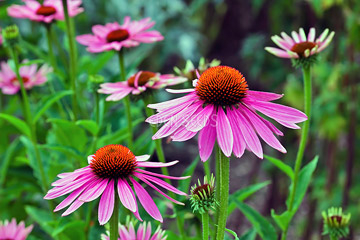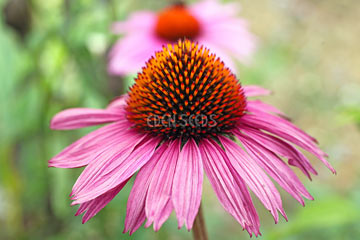Gardening Articles
Growing Echinacea
By Penny Ossowski
There are some plants which can provide beautiful perfumed flowers in our gardens, make wonderful cut flowers for inside as well as being a highly valued herb.

This description is very applicable to Echinacea. While it is best known for its medicinal qualities it is becoming increasingly grown for its flowers. Echinacea comes in several varieties the most common of which are Echinacea purpurea, Echinacea angustifolia and Echinacea pallida. These are members of the Asteraceae (daisy) family which originated on the prairies and woodlands of eastern and central North America. They were found at the time of the European settlement of these areas. The name Echinacea comes for the Greek ‘echino’ meaning spiny probably because of the spiny cone in the middle of the flower, it is this cone which gives the plant its common name coneflower. The cone at the centre of the flower shows after the flower has been pollinated then it fully opens and the petals point downwards giving the centre the appearance of a cone,
Echinacea seeds are available online from Eden Seeds and Select Organic.
Echinacea plants will tolerate drought, frost and some varieties also do well in our humid summers. They are a deciduous perennial which grow up to 1.5metres tall and will bloom from early summer to late autumn. Depending on variety, flowers are most commonly purple, pink or white however breeders have recently introduced colours ranging from hot red to sunset pinks, pale yellows and oranges, with variations of cone size and size of plants, all with a beautiful perfume, so there is sure to be at least one to suit your garden.
While preferring loamy well drained soil in full sun this low maintenance plant will grow in almost any soil type even with a little shade but not full shade. It can be grown from seed, root cuttings or basal cuttings. Seeds are best planted in early spring while root cuttings or division should be carried out in autumn or late winter and basal cutting in early spring. When growing from seed put the seeds in the fridge for a week before planting or stratify seeds before planting. Echinacea purpurea does better in our humid climate than Echinacea augustfolia. Snails and slugs like the tender leaves of Echinacea seedlings.

When Europeans first saw Echinacea they observed how the American Indians used it. Many Indian tribes including the Cheyenne, the Pawnee, the Kiowa and the Sioux used it for many problems. Some of its uses were for sore throats, toothache, snake bite, anthrax, coughs and for relief of pain. Today in Western Herbal medicine it is referred to as the most important immune stimulant. It is said that Echinacea stimulates the immune system and increases the activity of the immune system by helping white blood cells attack germs but it is also said that these effects may decrease if taken for more than a few weeks. It is purported to have antiseptic, antiviral and antifungal properties which can aid with the treatment of colds, coughs and flu, wounds, psoriasis, eczema and other skin problems. The whole plant can be used with the leaves making a tea used straight or added to fruit or vegetable juice and a decoction can be made from the root. The medicinal properties vary in different species of Echinacea. BUT be wary as some people have an allergic reaction to Echinacea in the form of anaphylaxis, asthma attacks, abdominal pain, nausea, myalgia, and dizziness.
For me these plants have a place in all gardens if not for their herbal qualities, colourful beauty or perfume then for the beneficial insects, bees, hoverflies and butterflies, they will attract to your garden.



